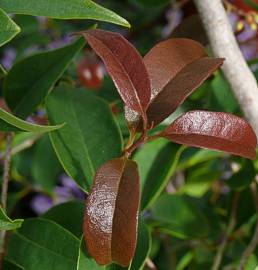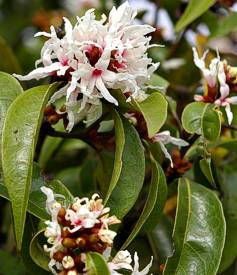Trichocladus grandiflorus
Trichocladus grandiflorus Oliv.
Family: Hamamelidaceae
Common names: honeysuckle tree; wild peach, green hazel, green witch-hazel (Eng.); rooihout, groenhaselaar (Afr.); ugabavu (Swazi)
SA Tree No: 144
Introduction
Trichocladus grandiflorus is a most handsome and easily cultivated ornamental tree, well deserving of a place in any garden, yet it remains as little known to most South Africans today as when it was first discovered by botanists in the 1880s.

Description
Description
Trichocladus grandiflorus is a most attractive, medium to large ornamental tree, 5-9 m high, occasionally growing much taller, depending upon its position and amount of protection. Specimens up to 30 m have been recorded. The main stem is a brownish grey and older specimens have flaking bark. The leaves are glossy green on top and paler below. The young foliage is a rich reddish colour and very attractive. The flowers are packed in dense heads at the ends of branches or in the leaf axils; they are very attractive, consisting of narrow, crinkled, petals that reflex. The petals are white with a beautiful pink, red or purple throat. The tree creates spectacular splashes of white along forest edges from spring to midsummer (September to January). Fruits are small and green turning brown and look like little acorns.

Conservation Status
Status
Trichocladus grandiflorus is widely distributed in a range of habitats many of which are protected, so this species has been classified in the National Red List of South African Plants, 2009 as Least Concern.
Distribution and habitat
Distribution description
Trichocladus grandiflorus is endemic to the eastern summer rainfall regions of South Africa in higher rainfall areas from KwaZulu-Natal through Swaziland, Mpumalanga to the Limpopo Province. It grows in a range of habitats ranging from 300-1800 m including the fringe of mountain mist belt forests to deep wooded ravines and evergreen forests at low altitudes.
Derivation of name and historical aspects
History
The name Trichocladus is derived from the Greek, trichos, meaning hairy or hair-like and klados, meaning branches or shoots, referring to the hairs on the young shoots; and grandiflorus means large-flowered, describing its large showy flowers.
Trichocladus grandiflorus was first collected by Mr Chris Mudd who sent seeds to a British nurseryman, Mr Veitch in 1883. It was illustrated in Curtis's Botanical Magazine from plants that flowered for the first time in the Temperate House at Kew Botanical Gardens in July 1894 (view the plate on Aluka.com). The botanist, Burtt Davy also made mention of this plant and its lovely flowers and red-brown new growth after seeing it flowering in the Eastern Transvaal (now Mpumalanga) in the early years of the 20th century. Despite this species being a most handsome and easily cultivated ornamental tree it remains as little known to most South Africans today as in the time of Chris Mudd and Burtt Davy.
It earned the common name wild peach because when it is in full flower the tree is almost completely covered with white flowers and is leafless, and resembles a flowering peach tree.
The Hamamelidaceae contains ± 30 genera and 100 species with a scattered, relict distribution in the temperate and subtropical regions of both hemispheres, and has the greatest diversity in eastern Asia. There is only one genus in Africa, namely Trichocladus, which contains three species in southern African and two species in eastern tropical Africa; one genus in Madagascar, Dicoryphe; and three Australian genera Ostrearia, Neostrearia and Noahdendron.
The family has very ancient origins, appearing soon after the first known angiosperms. The earliest Hamamelidaceae fossils are found in Europe, North America and China dating from the Late Cretaceous (100-65 million years ago) and it is thought that the group appeared on the ancient continent of Laurasia during the Early Cretaceous (145-100 m.y.a.) or possibly even earlier. The five Hamamelidaceae genera of the southern hemisphere share two unique characteristics that set them apart from their northern hemisphere relatives, and could result in them being separated into a new family: their anther thecae open by a single valve that serves both pollen sacs and they occur exclusively on land that was formerly part of the ancient continent of Gondwana. They are thought either to have spread via island connections between the separating landmasses of Laurasia and Gondwana; or they could have spread into India, Madagascar and Africa after the Indian plate collided with the Eurasian plate during the breakup of Gondwana; or the ancestor was already present in Gondwana in the Upper Cretaceous or earlier, before Laurasia and Gondwana split, but there is no fossil evidence to support any theory.
Ecology
Ecology
Trichocladus grandiflorus grows in areas of higher rainfall in or along the edges of forests in the summer rainfall region. It is deciduous in its natural habitat, but retains its foliage in milder climates such as found at Kirstenbosch.
Uses
Use
Trichocladus grandiflorus is a very beautiful ornamental tree that deserves a much higher profile as an excellent garden subject. It is not known to be used medicinally, nor is the wood used as timber. Branches of the closely related black witch-hazel (T. crinitus) from the coastal forests of the Western and Eastern Cape and KwaZulu-Natal are used as hoops for basket-making because the wood is tough and pliable and bends without breaking. The wood is said to be hard and was used for wagon work, and to make kieries (knobbed sticks) and ornaments.

Growing Trichocladus grandiflorus
Grow
Grow Trichocladus grandiflorus in a warm position in fertile, well-drained soil and water generously, particularly during spring and summer. This tree is well suited to small to medium-sized gardens in most regions of South Africa. It is one of a few trees that do not like full sunshine and it is sensitive to frost and drought. It is especially useful because it is quick growing and thrives in half shade. In the Western Cape it needs generous watering during the dry summer months. It responds well to good, well-composted soil and regular feeding. This species has performed well in large containers at Kirstenbosch.
Trichocladus grandiflorus is easy to grow from seed and cuttings. It comes from the summer rainfall region and therefore is best propagated at the beginning of summer when it begins its seasonal active growth cycle. Seed is sown in a well-drained medium consisting of a mixture of coarse river sand and well-rotted compost. Seed trays are placed in a warm position to optimize germination. Seeds may be protected from damping off by dusting them, or watering with a fungicide suited to the purpose.
This tree is easily propagated from tip or heel cuttings taken in early summer or throughout the warm months. Cuttings must be selected from thin, semi-hardwood material and treated with a rooting hormone. Place cuttings in a well-drained and aerated rooting medium such as equal parts of fine composted pine bark and perlite. It is recommended that cuttings be placed in multi-trays so that they can root in individual compartments. This helps prevent disturbance of other cuttings and the spread of infections.
Rooted cuttings or seedlings must be planted in a container or bag proportionate to the size of the plant. Placing small plants in much larger containers is not good practice and can affect the development of a healthy plant. Trichocladus grandiflorus will grow well in a normal, well-drained potting medium available at nurseries.
References
- Coates Palgrave, M. 2002. Keith Coates Palgrave Trees of southern Africa, edn 3. Struik, Cape Town.
- Leistner, O.A. (ed.). 2000. Seed plants of southern Africa: families and genera. Strelitzia 10. National Botanical Institute, Pretoria.
- Palmer, E. & Pitman, N. 1972. Trees of southern Africa, vol. 1: 671, 672. Balkema, Cape Town.
- Pooley, E. 1993. The complete field guide to trees of Natal, Zululand and the Transkei. Natal Flora Publications Trust, Durban.
- Smith, C.A. 1966. Common names of South African plants. Memoirs of the Botanical Survey of South Africa No. 35.
- Stearn, W.T. 2004. Botanical Latin. Timber Press, Portland, Oregon.
- Van Wyk, A.E. (Braam) & Van Wyk, P. 1997. Field guide to trees of southern Africa. Struik, Cape Town.
- Zhi-yun, Z. & An-ming, L. 1995. Hamamelidaceae: geographic distribution, fossil history and origin. Acta Phytotaxonomica Sinica 33: 313-339.
- website: http://www.aluka.org /Trichocladus grandiflorus Oliver original illustration from Curtis's Botanical Magazine.
- website: National Red List of South African plants, February 2009. http://www.sanbi.org/biodiversity/reddata.htm
Credits
Anthony Hitchcock & Alice Notten
Kirstenbosch National Botanical Garden
July 2009
Plant Attributes:
Plant Type: Tree
SA Distribution: Eastern Cape, KwaZulu-Natal, Mpumalanga
Soil type: Sandy, Loam
Flowering season: Spring, Early Summer
PH: Acid
Flower colour: White, Pink
Aspect: Full Sun, Morning Sun (Semi Shade), Afternoon Sun (Semi Shade)
Gardening skill: Easy
Special Features:
Horticultural zones









Rate this article
Article well written and informative
Rate this plant
Is this an interesting plant?
Login to add your Comment
Back to topNot registered yet? Click here to register.